Database Management System (DBMS) - ER Modeling basic concepts | 12th Computer Applications : Chapter 3 : Introduction to Database Management System (DBMS)
Chapter: 12th Computer Applications : Chapter 3 : Introduction to Database Management System (DBMS)
ER Modeling basic concepts
ER Model
Generally we use an ER model to know the concept of
database design and this model consists of a collection of entities(real world
objects)where each of these entities will be interconnected with each other
with conditions and dependencies(i.e. one entity is dependent on another).
ER
Modeling basic concepts
The basic concepts of ER model consists of
1. Entity or Entity type
2. Attributes
3. Relationship
These are the general concepts which help to create
an ER diagram and produce an ER model. With the help of these any database
design can be created and viewed to know the concept in that database design.
1. Entity or Entity type
An Entity can be anything a real-world object or
animation which is easily identifiable by anyone even by a common man.
Eg: In a company’s database Employee, HR, Manager
are considered as entities, where each of these entity will be having their own
attributes. An entity is represented by a rectangular box. See Figure 3.5.

Types of Entity:
1. Strong Entity
2. Weak Entity
3. Entity Instance
1. Strong Entity
A Strong entity is the one which doesn’t depend on
any other entity on the schema or database and a strong entity will have a
primary key with it (i.e. a unique id which other entities will not have in
their attributes).It is represented by one rectangle.In the above example it is
a strong entity because it has a primary key(a unique id) as the roll no because for
every one roll no varies and it will not be same.
2. Weak Entity
A weak entity is dependent on other entities and it
doesn’t have any primary key like the Strong entity. It is represented by
double rectangle.
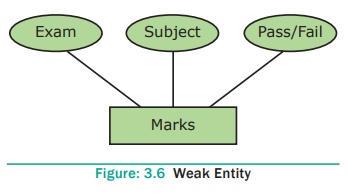
For Example:
Here the marks is the weak entity and there are no
unique id or primary key for that entity. So they are dependent on the
existence of the other entity. See Table 3.3
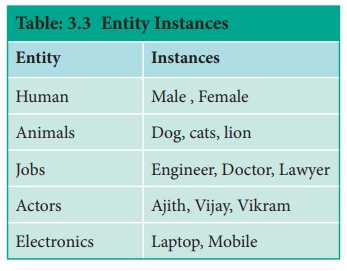
Table: 3.3 Entity Instances
Entity : Instances
Human : Male , Female
Animals : Dog, cats, lion
Jobs : Engineer, Doctor, Lawyer
Actors : Ajith, Vijay, Vikram
Electronics : Laptop, Mobile
3. Entity Instance
Instances are the values for the entity if we consider animals as the entity their instances will be dog, cat, cow… Etc. So an Entity Instance denotes the category values for the given entity.
2. Attributes
An attribute is the information about that entity
and it will describe, quantify, qualify, classify, and specify an entity. An
attribute will always have a single value, that value can be a number or
character or string.
Types of attributes:
1. Key Attribute
2. Simple Attributes
3. Composite Attributes
4. Single Valued Attribute
5. Multi Valued Attribute
1. Key Attribute
Generally a
key attribute describes a unique characteristic of an entity.
2. Simple Attribute
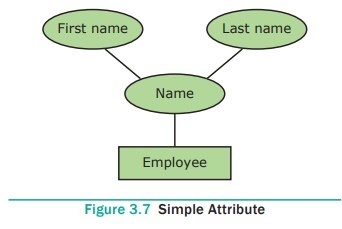
The simple attributes cannot be separated. It will
have a single value for that entity. For Example: Let us consider the name as
the attribute for the entity employee and here the value for that attribute is
a single value. See Figure 3.7
3. Composite Attributes
The composite attributes can be sub-divided into
simple attributes without change in the meaning of that attribute. For Example:
In the above diagram the employee is the entity with the composite attribute Name
which are sub-divided into two simple attributes first and last name.
4. Single Valued Attributes:
A single valued attribute contains only one value
for the attribute and they don’t have multiple number of values. For
Example:Age- It is a single value for a person as we cannot give ‘n’ number of
ages for a single person,therefore it is a single valued attribute. See Table
3.4
Table:
3.4 Single Valued Attributes
Attribute
Values
Age : 3
Roll no : 85
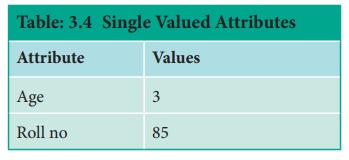
In the above table are the some examples for single
valued attributes. See Figure 3.8
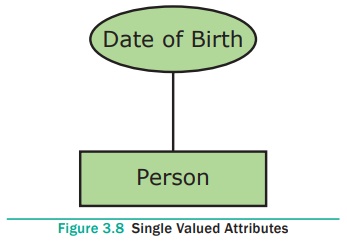
5. Multi Valued Attributes:
A multi valued attribute has more than one value
for that particular attribute.For Example:Degree - A person can hold n number
of degrees so it is a multi-valued attribute.
In Table 3.5 are some examples for Multi valued
attributes.
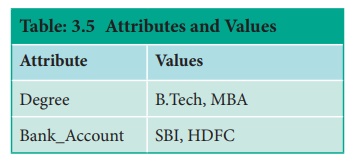
3. Relationship Type
In ER Model, relationship exists between two
entities. Three types of relationships are available and the Entity-Relationship(ER)
diagram is based on the three types listed below.
One-to-One
relationship: Consider two
entities A and B. one-to -one (1:1) relationship is said to exist in a
relational database design, if 0 or 1 instance of entity A is associated with 0
or 1 instance of entity B, and 0 or 1 instance of entity B is associated with 0
or 1 instance of entity A.
One-to-Many
relationship: Consider two
entities A and B. one- to-many (1:N) relationship is said to exist in a
relational database design, for 1 instance of entity A there exists 0 or 1 or
many instances of entity B, but for 1 instance of entity B there exists 0 or 1
instance of entity A.
Many-to-Many
relationship: Consider two
entities A and B. many -to-many (M:N) relationship is said to exist in a relational
database design, for 1 instance of entity A there exists 0 or 1 or many
instances of entity B, and for 1 instance of entity B there exists 0 or 1 or
many instance of entity A.
In reality one-to-one are in less usage, where as
one-to-many and many-to-many are commonly used. However in relational
databases, many- to-many are converted into one-to-many relationships.
1. Relationship instance
It is a finite set of liples in the RDBMS systems
relation instances never have duplicate . E.g if Works-for is the relationship between the Employee entity
and the department entity, then Ram works for
Comp.sc department, shyam works for electrical department ..etc are
relationship instances of the relationship, works for.
2. Degree of a relationship
The number of entity types involved is known as
Degree of relationship. One – Unary, Two – Binary, Three – Ternary.E.g An
employee of an organization acts as manager of few other employees. It also
connects one entity to itself as a loop. so manager-of is unary. Similarly employee works- fordepartment, connects two entities and is binary. If a
customer purchase an item, it involves shop keeper also and is a ternary
relationship.
3. Cardinality
It is defined as the number of items that must be
included in a relationship.ie number of entities in one set mapped with the
number of entities of another set via the relationship. The three
classifications in Cardinality are one -to- one, one-to-many and Many-to-Many.
See Figure 3.9-3.11

In the above example we have two entities Person
and Vehicle. If we consider a person driving vwchicle, then we have one-to-one
relationship between Person and Vehicle. See Figure 3.10

In the above example, Customer places the Order is
a one-to-many relationship
Here the customer can place multiple orders and the
order is related to only one customer. See Figure 3.11

The example of many-to-many relationship is
Students registering the Courses. A student can register more than one courses
and A course can be registered by many students. Hence it is many-to-many.
Related Topics